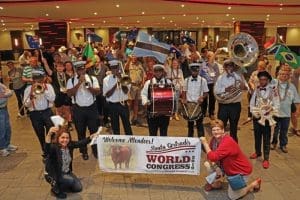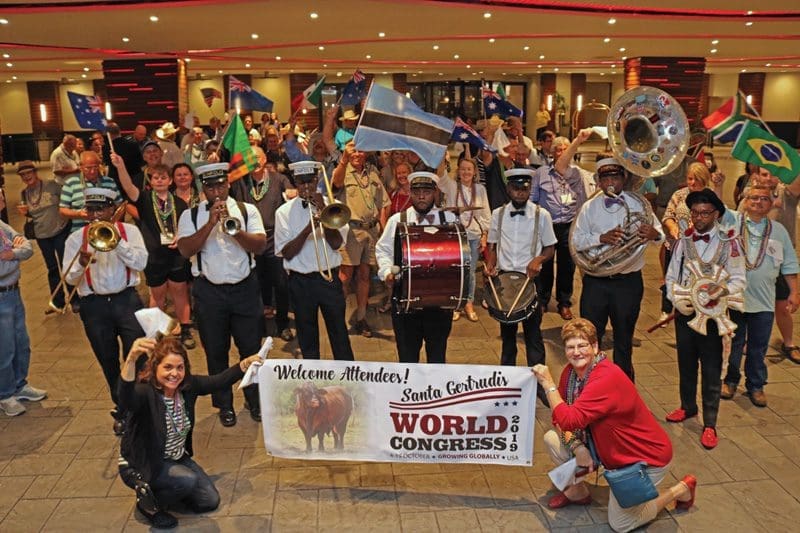By Larry Stalcup, Contributing Editor
There has nearly always been prejudice against Bos indicus cattle. “They won’t grade. The quality isn’t there. They can’t handle the cold.”
But with impressive feed-out results that would impress about any Bos taurus breed operator, Santa Gertrudis breeders can brag about EPDs that are “data-driven, and profit-proven.”
That’s what many of them did in October during the Santa Gertrudis World Congress 2019. The Santa Gertrudis Breeders International (SBGI) hosted Santa Gertrudis breeders representing 10 countries during a 17-day congress and tour. The tour included visits to Santa Gertrudis ranches in Georgia, Alabama, Mississippi, Louisiana and Texas. (CALF News was honored to serve as one of several World Congress sponsors.)
Its main business-related program was held in New Orleans, where dialogue on extensive development of high-quality genetics highlighted the event. National Cattlemen’s Beef Association (NCBA)President Jennifer Houston was among those who addressed the international group of producers.
She congratulated SGBI for its growth in recent years and outlined how the U.S. Beef Checkoff is helping domestic producers and feeders through beef promotion and marketing. She reminded U.S. producers that “no Checkoff funds” are used in financing NCBA policy activities.
John Ford, SGBI executive director in Kingsville, Texas, also praised Santa Gertrudis breeders for their support of the SGBI program to identify traits in purebred Santa Gertrudis sires and dams.
“In 2013 we became the first breed association in the world to adopt single-step methodology to incorporate DNA into the breed’s genetic makeup,” he said. “Due to SGBI members utilizing the association’s selection-making genetic tools, SGBI caught the attention of the nation’s larger breeds, like the Red Angus Association of America (RAAA).
“RAAA initiated discussion with us on joint programming. RAAA has a very successful tagged feeder calf program in place. Collaborating with them will now allow us to develop a feeder calf marketing program.”
SGBI has worked steadily with what is now Neogen, a major genetic testing company, to develop DNA-based data on purebred Santa Gertrudis, F1 and Santa Gertrudis crosses. “You are rapidly moving your genetics process,” said Ashby Green of Neogen (formerly Livestock Genetic Services). “Data is what is delivering your proven process.”
Alfonzo Sanchez, whose family operates the Red Doc Ranch in Belen, N.M., had encouraging words for U.S. and international breeders. He pointed out the super feed-out numbers for cattle finished at Hereford Feedyard, part of AzTx Cattle Co., headquartered in Hereford, Texas.
In the research feed-out, purebred Santa Gertrudis steers representing 25 different sire groups were fed during the winter and spring of 2018 and harvested at Tyson in Amarillo, on June 29, 2018.
Data was collected by the Beef Carcass Research Center at West Texas A&M University in Canyon. At the bunk, the cattle had an ADG of 3.51 pounds per day. At the packer, they graded 96 percent Choice, with 51 percent hitting the Premium Choice mark.
“The data reveals that the Santa Gertrudis genetic package reaches desired Quality Grade targets and does so in an effective, efficient and profitable manner,” Sanchez said. He added that the steers’ average USDA Yield Grade (YG) was 2.98 with 50 percent of the carcasses scoring YG 1s and 2s. The data showed the steers had an average ribeye area 14 square inches.
Coping with the cold
Most of the Santa Gertrudis breeders on the tour were from warm geographical areas that have always been ideal for Bos indicus cattle. But Sanchez stressed that the Santa Gertrudis breed and Santa Gertrudis-cross cattle also work in colder climates, as was indicated in the Hereford Feedyard results.
Matt Garcia, a beef cattle specialist at Utah State University, said heterosis using Santa Gertrudis sires and Angus females also showed positive results. In his 2017-2018 feed-out studies, Garcia and his team AI’d cows with Santa Gertrudis semen. There were 160 total cows bred. For 2019, 160 cows were bred with Santa Gertrudis bulls.
Utah’s drier climate is less friendly to Angus females, Garcia said, but hybrid vigor from the Santa Gertrudis sires helped produce F1 calves that were better acclimated to pastures with lower quality grass.
The Utah trials were held across 14 counties. Some local ranchers balked at the program. Their prejudice against eared cattle was apparent. “But after viewing crossbred cattle in the feeding program, they realized the calves had no appearance of Brahman-influenced breeding,” Garcia said.
“In the recent feeding program, we didn’t lose one Santa Gertrudis-sired calf to freezing conditions, and we only lost three of the calves leading up to weaning.” But for Angus-sired calves, “11 were lost” in the cold Utah winter, Garcia added.
As in the first two years, Santa Gertrudis-sired conception rates were high. Of 80 cows bred, there was a 98 percent conception rate.
Brisket disease, or bovine pulmonary hypertension, has become a bigger problem in more mountainous areas. But not for eared cattle, Garcia said.
“We’ve never seen it in the Bos indicus cattle,” he said, noting that with that statistic and the powerful feed-out numbers, “the Santa Gertrudis breed has a huge opportunity” in crossbreeding programs in more northern states.
All breeds matter
The Santa Gertrudis breed was established at the King Ranch® on the Texas Coastal Bend in 1920. It was the first breed developed in the U.S., and was created to handle the warm climate. So, of course the King Ranch was a stopping point on the World Congress tour, along with Texas A&M University and the State Fair of Texas Santa Gertrudis Show in Dallas.
Ford said SGBI’s rationale is based on the fact that “knowledgeable cattlemen recognize that no single breed holds a monopoly on superior carcass quality.
“Research results clearly indicate that genetic variation exists both between and within breeds for many important beef cattle performance measures. Simply stated, selection within breed populations is a very effective tool for improving carcass traits.”
The SGBI website notes that there are nearly 11,000 Santa Gertrudis genotypes on record with data to back up the breed’s claims, and that “Santa Gertrudis has earned its rightful place in the beef industry.”
“SGBI’s reliable genetic evaluation ensures that cattlemen can make sound comparisons and identify genetics that will perform at the highest level,” Ford said, adding that SGBI’s genetic evaluation ensures that industry members can make profitable selection decisions.
“SGBI’s spirit of innovation, along with decades of solid data collection and partnerships with world-leading animal scientists, geneticists and service providers create a solid foundation for its predictable genetic evaluation.
“We’re a data-driven, profit-proven breed.”







